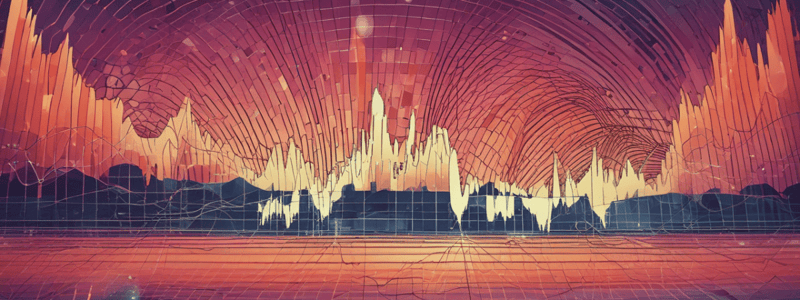Podcast
Questions and Answers
What is the typical formation of a head-and-shoulders bottom pattern?
What is the typical formation of a head-and-shoulders bottom pattern?
- A lower resistance level, then a higher resistance level, and finally a lower resistance level again
- A lower support level, then a higher support level, and finally a lower support level again (correct)
- A higher resistance level, then a lower resistance level, and finally a higher resistance level again
- A higher support level, then a lower support level, and finally a higher support level again
What type of trend is usually associated with the formation of a head-and-shoulders top?
What type of trend is usually associated with the formation of a head-and-shoulders top?
- Down trend
- Sideways trend
- Up trend (correct)
- Exhaustion trend
What is the characteristic of the right shoulder in a head-and-shoulders top pattern?
What is the characteristic of the right shoulder in a head-and-shoulders top pattern?
- A higher horizontal level of resistance
- A horizontal level of support that is in line with the left shoulder
- A horizontal level of resistance that is in line with the left shoulder (correct)
- A lower horizontal level of resistance
Which of the following patterns is NOT a type of reversal pattern?
Which of the following patterns is NOT a type of reversal pattern?
What is the difference between a head-and-shoulders top and a head-and-shoulders bottom?
What is the difference between a head-and-shoulders top and a head-and-shoulders bottom?
What is the primary function of the breakout point in a triple top or triple bottom formation?
What is the primary function of the breakout point in a triple top or triple bottom formation?
In a head-and-shoulders top, what is the price level that forms the second shoulder?
In a head-and-shoulders top, what is the price level that forms the second shoulder?
What is the characteristic of a triple top formation that makes it different from a head-and-shoulders top?
What is the characteristic of a triple top formation that makes it different from a head-and-shoulders top?
What is the price projection in a triple bottom formation?
What is the price projection in a triple bottom formation?
What is the significance of the breakout point in a head-and-shoulders pattern?
What is the significance of the breakout point in a head-and-shoulders pattern?
What is an inverse head and shoulder pattern?
What is an inverse head and shoulder pattern?
What is the purpose of measuring the distance between the head and the neckline in a head-and-shoulders pattern?
What is the purpose of measuring the distance between the head and the neckline in a head-and-shoulders pattern?
What is the importance of volume in the completion of a head-and-shoulders pattern?
What is the importance of volume in the completion of a head-and-shoulders pattern?
What is the difference between a head-and-shoulders top and a head-and-shoulders bottom?
What is the difference between a head-and-shoulders top and a head-and-shoulders bottom?
What is the significance of the neckline in a head-and-shoulders pattern?
What is the significance of the neckline in a head-and-shoulders pattern?
What happens to the price movement after the handle in a cup and handle pattern is broken?
What happens to the price movement after the handle in a cup and handle pattern is broken?
What type of chart pattern is formed when the price movement pushes above the resistance lines formed in the handle?
What type of chart pattern is formed when the price movement pushes above the resistance lines formed in the handle?
What is the typical time frame for a cup and handle pattern to form?
What is the typical time frame for a cup and handle pattern to form?
What is the significance of a reversal pattern during an uptrend?
What is the significance of a reversal pattern during an uptrend?
A flag pattern is a type of reversal chart pattern.
A flag pattern is a type of reversal chart pattern.
The distance the currency pair is projected to move is equal to the height of the flag.
The distance the currency pair is projected to move is equal to the height of the flag.
A wedge is a type of reversal chart pattern.
A wedge is a type of reversal chart pattern.
A flag pattern can be either bullish or bearish, depending on the trend before the flag formed.
A flag pattern can be either bullish or bearish, depending on the trend before the flag formed.
Wedges are typically formed over longer periods of time.
Wedges are typically formed over longer periods of time.
Flashcards
Head-and-Shoulders Top
Head-and-Shoulders Top
A bearish reversal pattern formed during an uptrend. It consists of three peaks, with the middle peak (head) being higher than the other two (shoulders).
Head-and-Shoulders Bottom
Head-and-Shoulders Bottom
A bullish reversal pattern formed during a downtrend. It consists of three troughs, with the middle trough (head) being lower than the other two (shoulders).
Triple Top
Triple Top
A reversal pattern that consists of three price peaks (tops) that hit approximately the same resistance level. It signals a potential bearish reversal.
Triple Bottom
Triple Bottom
Signup and view all the flashcards
Cup and Handle
Cup and Handle
Signup and view all the flashcards
Reversal Patterns
Reversal Patterns
Signup and view all the flashcards
Triangles
Triangles
Signup and view all the flashcards
Wedges
Wedges
Signup and view all the flashcards
Flags
Flags
Signup and view all the flashcards
Study Notes
Head and Shoulders Tops/Bottoms
- Reversal patterns formed as price hits a support/resistance level (first shoulder), breaks through, hits a lower/higher level (head), and then hits the first support/resistance level again (second shoulder)
- Bearish reversal patterns (head-and-shoulders tops) form in uptrends, while bullish reversal patterns (head-and-shoulders bottoms) form in downtrends
- Form over long periods of time
- Characterized by:
- Left shoulder: horizontal/slightly angled level of resistance (head-and-shoulders top) or support (head-and-shoulders bottom)
- Head: higher/lower horizontal/slightly angled level of resistance (head-and-shoulders top) or support (head-and-shoulders bottom)
- Right shoulder: horizontal/slightly angled level of resistance (head-and-shoulders top) or support (head-and-shoulders bottom) in line with the left shoulder
- Breakout point: where price breaks up above/breaks down below the neckline
- Price projection: distance between head and neckline, indicating the price movement after breakout
Triple Tops/Bottoms
- Reversal patterns formed as price hits a resistance/support level, breaks through, hits a higher/lower level, and then hits the first resistance/support level again
- Form over long periods of time
- Characterized by:
- Breakout point: where price breaks up above/breaks down below the horizontal level of resistance (triple top) or support (triple bottom)
- Price projection: distance between support and resistance levels, indicating the price movement after breakout
Cup and Handle
- Bullish continuation pattern that forms after an uptrend has paused
- Characterized by a cup-shaped formation, followed by a handle (generally downward/sideways movement)
- Once the price breaks above the resistance line formed in the handle, the uptrend continues
- Forms over a wide range of time frames, from several months to over a year
Reversal Patterns
- Signal a change in the ongoing trend
- Can be bullish (upward trend) or bearish (downward trend)
- Also referred to as trend reversal, rally, or correction
- Form during uptrends or downtrends, indicating a potential reversal in the trend
Triangles
- Continuation patterns that form as price hits a flat level of support or resistance and moves into a tighter consolidation range
- Can be bullish or bearish, depending on the trend before the triangle formed
- Characterized by:
- Resistance level: horizontal level of resistance (bullish triangle) or down-trending level of resistance (bearish triangle)
- Support level: up-trending level of support (bullish triangle) or horizontal level of support (bearish triangle)
- Breakout point: where price breaks up above/breaks down below the resistance/support level
- Price projection: distance between the resistance and support levels, indicating the price movement after breakout
Wedges
- Continuation patterns that form as price pulls back from the predominant trend and moves into a tighter consolidation range
- Can be bullish or bearish, depending on the trend before the wedge formed
- Characterized by:
- Breakout point: where price breaks up above/breaks down below the wedge formation
- Price projection: distance between the resistance and support levels, indicating the price movement after breakout
- Form over shorter periods of time compared to other patterns
Flags
- Continuation patterns that form as price pulls back from the predominant trend and moves into a tighter consolidation range
- Can be bullish or bearish, depending on the trend before the flag formed
- Characterized by:
- Flag pole: the trend preceding the formation of the flag
- Breakout point: where price breaks up above/breaks down below the downtrending level of resistance (bullish flag) or uptrending level of support (bearish flag)
- Price projection: distance between the flag pole and the breakout point, indicating the price movement after breakout
Studying That Suits You
Use AI to generate personalized quizzes and flashcards to suit your learning preferences.



